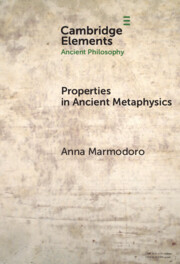Element contents
Properties in Ancient Metaphysics
Published online by Cambridge University Press: 29 November 2023
Summary
- Type
- Element
- Information
- Series: Elements in Ancient PhilosophyOnline ISBN: 9781009105866Publisher: Cambridge University PressPrint publication: 21 December 2023
References
Primary Sources
Secondary Sources
- 3
- Cited by

